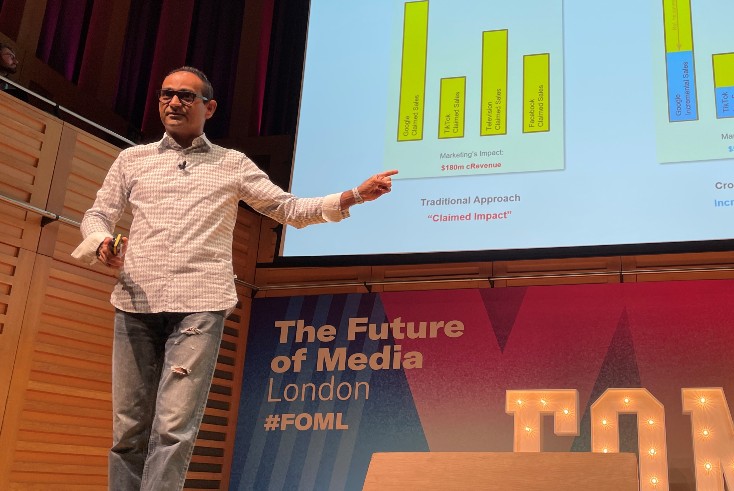How to make marketing indispensable to the CFO? Focus on incrementality

The Future of Media London 2024
“We have to make sure marketing is indispensable to the CFO, not the CMO.”
At The Future of Media London, Avinash Kaushik, chief strategy officer at digital media agency Croud, passionately argued that the vast majority of current media planning practices miss the mark by failing to focus on incrementality.
“The best thing I can do for the CMO [chief marketing officer] is to make him or her bullet-proof to the CFO [chief financial officer],” he said — a tough problem given that CFOs “don’t put up with a lot of bullshit”.
And the best way to prove marketing is a worthwhile investment, Kaushik suggested, is to “obsess” about incremental uplift with target audiences.
‘You wouldn’t even miss’ most marketing
Kaushik, who spent 16 years at Google before joining Croud in 2023, humorously defined incrementality as “simply what would happen if you fire every single person in marketing”.
“Most of you may not realise that if we fired everyone in marketing at every company, profits instantly go up,” he said to laughter from a packed audience at Kings Place in London. “Because the reality is most of us do marketing that is actually not incremental. You wouldn’t even miss it.
“The difference is: is your marketing good enough that your company would miss it in six months? Nine months? Two years? At some point, the company will get fucked.”
Kaushik continued: “My job is to make sure the company realises that if you fire everyone in marketing, you’re going to miss it next week, not two years from now.”
Measuring for incrementality
Kaushik noted that there are three levels of incrementality to consider: channel silo incrementality, channel stack incrementality and overall portfolio incrementality.
He said most channels can themselves answer the question for free on the incrementality they delivered for a given campaign, typically through the use of conversion lift studies.
“If your internal team and agency is not reporting channel silo incrementality, they’re secretly plotting to get you fired,” joked Kaushik. “Because it is such a cheap and easy question to answer.”
Kaushik defined stack incrementality as the incrementality given by a combination of spending on multiple platforms from the same or similar companies — for example, both Google Search and YouTube or both Facebook and Instagram.
Portfolio incrementality then seeks to measure the incremental outcome of an entire marketing campaign across all channels. Kaushik recommended large-scale controlled experiments, as well as using new machine learning tools based on mixed modelling, to calculate incremental impact.
“We’re still an industry that’s obsessed with reach and ‘likes’ and followers and, God forbid, influencers,” Kaushik said to more laughter.
“You all laugh, but you’re spending money on that!”
Plan for outcomes, not reach
Kaushik argued that current media planning conducted by “99% of agencies and companies” is too reach-centric and needlessly chasing scale.
“You bombard your ad out in the world and then you run out of money before you’ve had time to persuade anybody about what you’re saying,” he explained.
Indeed, he warned against making ads that impress internal leadership rather than the actual target audience.
“The problem is, you and your CMO and your VP of whatever-the-hell-agency are the only people that will sit down and watch your ad carefully. Nobody gives a shit,” Kaushik exclaimed.
“None of us wake up every single day in marketing and say ‘I can’t wait to see ads today!’ No-one. Not even you! Just look at the level of likes your companies’ things are getting on Instagram. You have more employees than the likes you’re getting on a post. Your own employees don’t give a shit!”
While Kaushik admitted that many ad campaigns that go big on reach are great at winning awards at Cannes Lions, they usually aren’t great at driving business effectiveness.
“You need to figure out how to be in the business of persuasion,” he pleaded. “Not just reaching people.”
Kaushik recommended an outcome-based planning model that starts by seeking to improve brand lift and purchase intent, then works backwards to figure out how much frequency of ad delivery is needed to persuade a target audience.
‘Make a great creative — your audience will find it’
Kaushik added, however, that creative still plays an outsized role in any ad campaign’s effectiveness.
Admitting that he only learned the value of creative “10 years ago”, he noted that it is responsible for 60-70% of all success in marketing.
“Not the media strategy, not the targeting, audience research… not all the other bullshit we do in marketing,” he said. Rather, Kaushik argued that the best media strategy and the best targeting strategy is a great creative.
“Don’t worry about micro-targeting and all the other bullshit we’re spending money on. Just make a great creative — your audience will find it.”
And that great creative needs to be tested, Kaushik added, against the campaign’s targeted audience and not the CMO or the CFO. Furthermore, marketers should concern themselves most with the impact an ad has on purchase intent and brand uplift, rather than other measurements of emotional response to the ad.
“There’s a whole bunch of creative we make that the CMO loves, the VP of marketing loves, the creative director loves,” he added. “I don’t care.”




